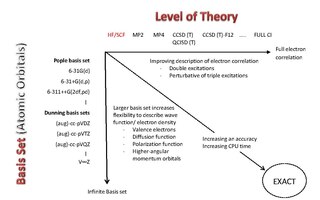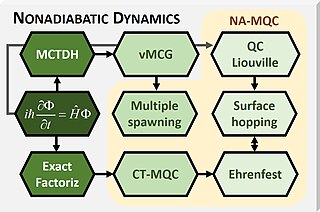Related Research Articles
Computational chemistry is a branch of chemistry that uses computer simulation to assist in solving chemical problems. It uses methods of theoretical chemistry, incorporated into computer programs, to calculate the structures and properties of molecules, groups of molecules, and solids. It is necessary because, apart from relatively recent results concerning the hydrogen molecular ion, the quantum many-body problem cannot be solved analytically, much less in closed form. While computational results normally complement the information obtained by chemical experiments, it can in some cases predict hitherto unobserved chemical phenomena. It is widely used in the design of new drugs and materials.

Dudley Robert Herschbach is an American chemist at Harvard University. He won the 1986 Nobel Prize in Chemistry jointly with Yuan T. Lee and John C. Polanyi "for their contributions concerning the dynamics of chemical elementary processes". Herschbach and Lee specifically worked with molecular beams, performing crossed molecular beam experiments that enabled a detailed molecular-level understanding of many elementary reaction processes. Herschbach is a member of the Board of Sponsors of the Bulletin of the Atomic Scientists.
Vibronic coupling in a molecule involves the interaction between electronic and nuclear vibrational motion. The term "vibronic" originates from the combination of the terms "vibrational" and "electronic", denoting the idea that in a molecule, vibrational and electronic interactions are interrelated and influence each other. The magnitude of vibronic coupling reflects the degree of such interrelation.
This is a timeline of subatomic particle discoveries, including all particles thus far discovered which appear to be elementary given the best available evidence. It also includes the discovery of composite particles and antiparticles that were of particular historical importance.

Ruthenium(III) chloride is the chemical compound with the formula RuCl3. "Ruthenium(III) chloride" more commonly refers to the hydrate RuCl3·xH2O. Both the anhydrous and hydrated species are dark brown or black solids. The hydrate, with a varying proportion of water of crystallization, often approximating to a trihydrate, is a commonly used starting material in ruthenium chemistry.

Richard Neil Zare is the Marguerite Blake Wilbur Professor in Natural Science and a Professor of Chemistry at Stanford University. Throughout his career, Zare has made a considerable impact in physical chemistry and analytical chemistry, particularly through the development of laser-induced fluorescence (LIF) and the study of chemical reactions at the molecular and nanoscale level. LIF is an extremely sensitive technique with applications ranging from analytical chemistry and molecular biology to astrophysics. One of its applications was the sequencing of the human genome.
Joel Mark Bowman is the Samuel Candler Dobbs Professor of Theoretical Chemistry at Emory University. He is the author of more than 500 publications, a member of the International Academy of Quantum Molecular Sciences, and a fellow of the American Physical Society and of the American Association for the Advancement of Science. His research interests are in basic theories of chemical reactivity; his AAAS fellow citation cited him “for distinguished contributions to reduced dimensionality quantum approaches to reaction rates and to the formulation and application of self-consistent field approaches to molecular vibrations.” Several of his recent papers have appeared in the journal Science.
Inelastic electron tunneling spectroscopy (IETS) is an experimental tool for studying the vibrations of molecular adsorbates on metal oxides. It yields vibrational spectra of the adsorbates with high resolution (< 0.5 meV) and high sensitivity (< 1013 molecules are required to provide a spectrum). An additional advantage is the fact that optically forbidden transitions may be observed as well. Within IETS, an oxide layer with molecules adsorbed on it is put between two metal plates. A bias voltage is applied between the two contacts. An energy diagram of the metal-oxide-metal device under bias is shown in the top figure. The metal contacts are characterized by a constant density of states, filled up to the Fermi energy. The metals are assumed to be equal. The adsorbates are situated on the oxide material. They are represented by a single bridge electronic level, which is the upper dashed line. If the insulator is thin enough, there is a finite probability that the incident electron tunnels through the barrier. Since the energy of the electron is not changed by this process, it is an elastic process. This is shown in the left figure.
Crossed molecular beam experiments are chemical experiments where two beams of atoms or molecules are collided together to study the dynamics of the chemical reaction, and can detect individual reactive collisions.
Michał Gryziński was a Polish nuclear physicist, plasma physics specialist and the founder of the free-fall atomic model, an alternative theoretical formulation, a classical approximation asking for trajectories of electron averaging to probability densities described by quantum mechanics.

Donald Gene Truhlar is an American scientist working in theoretical and computational chemistry and chemical physics with special emphases on quantum mechanics and chemical dynamics.

James Bernhard Anderson was an American chemist and physicist. From 1995 to 2014 he was Evan Pugh Professor of Chemistry and Physics at the Pennsylvania State University. He specialized in Quantum Chemistry by Monte Carlo methods, molecular dynamics of reactive collisions, kinetics and mechanisms of gas phase reactions, and rare-event theory.
Franz Josef Gießibl is a German physicist and university professor at the University of Regensburg.

A Pople diagram or Pople's Diagram is a diagram which describes the relationship between various calculation methods in computational chemistry. It was initially introduced in January 1965 by Sir John Pople,, during the Symposium of Atomic and Molecular Quantum Theory in Florida. The Pople Diagram can be either 2-dimensional or 3-dimensional, with the axes representing ab inito methods, basis sets and treatment of relativity. The diagram attempts to balance calculations by giving all aspects of a computation equal weight.
Vincenzo Aquilanti is an Italian chemist, emeritus professor at the University of Perugia.

Bretislav Friedrich is a Research Group leader at the Department of Molecular Physics, Fritz-Haber-Institut der Max-Planck-Gesellschaft and Honorarprofessor at the Technische Universität in Berlin, Germany. He is globally recognized for his pioneering research surrounding interaction of molecules with and in electric, magnetic, and optical fields as well as on cold molecules. He was admitted to the Learned Society of the Czech Republic in 2011.
Shortcuts to adiabaticity (STA) are fast control protocols to drive the dynamics of system without relying on the adiabatic theorem. The concept of STA was introduced in a 2010 paper by Xi Chen et al. Their design can be achieved using a variety of techniques. A universal approach is provided by counterdiabatic driving, also known as transitionless quantum driving. Motivated by one of authors systematic study of dissipative Landau-Zener transition, the key idea was demonstrated earlier by a group of scientists from China, Greece and USA in 2000, as steering an eigenstate to destination. Counterdiabatic driving has been demonstrated in the laboratory using a time-dependent quantum oscillator.

Mixed quantum-classical (MQC) dynamics is a class of computational theoretical chemistry methods tailored to simulate nonadiabatic (NA) processes in molecular and supramolecular chemistry. Such methods are characterized by:
- Propagation of nuclear dynamics through classical trajectories;
- Propagation of the electrons through quantum methods;
- A feedback algorithm between the electronic and nuclear subsystems to recover nonadiabatic information.
Mario Barbatti is a Brazilian physicist, computational theoretical chemist, and writer. He is specialized in the development and application of mixed quantum-classical dynamics for the study of molecular excited states. He is also the leading developer of the Newton-X software package for dynamics simulations. Mario Barbatti held an A*Midex Chair of Excellence at the Aix Marseille University between 2015 and 2019, where he is a professor since 2015.
Evgeny E. Nikitin is a Russian theoretical chemist and emeritus professor at the Technion in Haifa, Israel.
References
- 1 2 "International Academy of Quantum Molecular Science biography of Millard Henry Alexander".
- ↑ "List of Distinguished University Professors, University of Maryland".
- ↑ "University of Maryland, Chemistry Faculty Profile for Millard Henry Alexander".
- ↑ "Institute for Physical Science and Technology, University of Maryland, College Park".
- ↑ Althorpe, S. C.; Clary, D. C. (2003), "Quantum scattering calculations on chemical reactions", Annu. Rev. Phys. Chem., 54: 493–529, Bibcode:2003ARPC...54..493A, doi:10.1146/annurev.physchem.54.011002.103750, ISSN 0066-426X, PMID 12651964 .
- ↑ Liu, K. P. (2006), "Recent advances in crossed-beam studies of bimolecular reactions", J. Chem. Phys., 125 (13): 132307, Bibcode:2006JChPh.125m2307L, doi:10.1063/1.2216706, ISSN 0021-9606, PMID 17029426 .
- ↑ "Dynamics of Molecular Collisions, Herschbach Medal, 2015".
- ↑ "Telluride Science Research Center, Board of Directors".